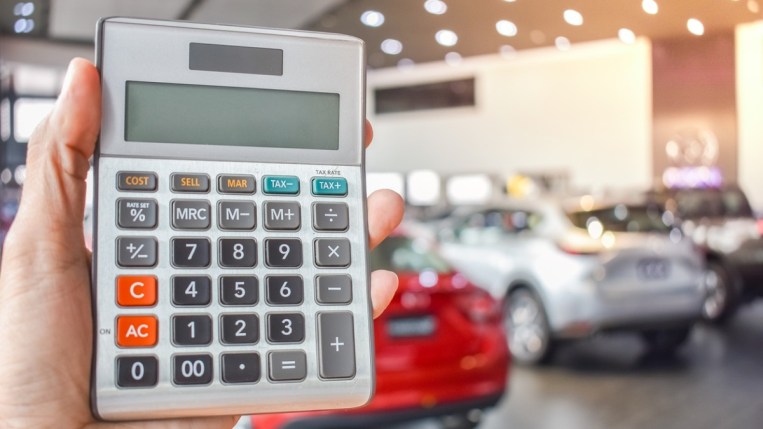Quick Facts on Car Affordability
- Some car models are in greater supply, offer greater carmaker incentives, and remain more affordable than others.
- It’s still a seller’s market for used cars.
- Interest rates for used cars remain higher, but are beginning to drop.
- Paying your car loan biweekly will save you money.
Today’s car sales market is looking up. If you’re shopping for a new car, discounts are plentiful, despite higher interest rates. Used car prices are holding steady, but inventory is tight. It’s an interesting market for buyers with a trade-in.
As consumers, one of the questions we seek guidance on is, can you afford to buy a car right now? Our answer is yes, with a few conditions. Let’s dig a little deeper and see if we can ease some of the uncertainty.
- What’s Happening With Car Prices Right Now?
- How Do Car Loan Interest Rates Impact Purchase Price?
- How Much Car Can I Afford?
- How to Afford a Car in This Economy
What’s Happening With Car Prices Right Now?
We start with current pricing trends so you can get a handle on your ability to afford a car right now.
What Is the Average Price for a New Car?
According to data from Cox Automotive, the parent of Kelley Blue Book, the average price a buyer paid for a new car at the end of 2024 was $49,740. However, incentive spending averages about $4,000, up 44% from the year prior.
Cox Automotive vAuto data shows that new car inventory is plentiful and shortages are mostly over. However, Lexus and Toyota dealerships show fewer days of supply than other carmakers. At the other end, you’ll find plenty of new Jaguar, Lincoln, Dodge, Buick, Mini, and Nissan vehicles.
Whether new or used vehicles, negotiating a better price from dealers today is easier than during the past several years when many cars were in short supply. That could help land you a great deal, including on electric cars.
What Is the Average Price for a Used Car?
According to Cox Automotive, the average used car transaction price at the start of December was $25,574 but has risen to $25,721 since then. However, the nationwide inventory of used cars for sale is down 5% from this time last year. Those aren’t great trends for shoppers looking to buy used vehicles.
Where Are Car Prices Going?
Rising interest rates last year began pushing down transaction prices for new and used vehicles. Now interest rates for car buyers are steadily declining, and that’s great news.
Yes, new car inventories started returning to normal, but some carmakers like Lexus, Toyota, BMW, and Honda still face depleted stock. Odds are prices will remain high on those and other Asian brand vehicles in the short term.
In the used car market, future supply will be constrained. Lean inventories of used vehicles will keep prices higher. Carmakers manufactured 8 million fewer vehicles during the pandemic, and fewer consumers leased vehicles. That means far fewer vehicles will become available in the used market for at least the next year. Additionally, shoppers priced out of the new car market, looked to buy used vehicles, adding to the pricing pressure in the used vehicle market.
RELATED ARTICLE: When Will New Car Prices Drop?
How Do Car Loan Interest Rates Impact Purchase Price?
Every car loan has some moving parts that, when added together, define how good a deal you scored on your vehicle purchase. The transaction price is the final cost of the vehicle after the down payment, trade-in, fees, taxes, and so forth. It also reflects your success in negotiating down the manufacturer’s suggested retail price (MSRP).
What do stubbornly high car prices have to do with interest rates? For consumers, finding the lowest interest rate possible is more important than ever when striving for car affordability.
The Cox Automotive and Moody’s Analytics Vehicle Affordability Index shows that monthly car payments were $756 at the end of 2024, the highest level since the summer.
“In December, new vehicles were only slightly less affordable than in the previous month,” said Jonathan Smoke, chief economist at Cox Automotive, the parent company of Kelley Blue Book. “Higher prices pushed the average monthly payment to a six-month high. However, we expect vehicle affordability to improve in 2025, driven by lower interest rates and increased incentives.”
How Do Interest Rates Impact Vehicle Cost?
Interest rates on used car loans will almost always be higher than on loans for new cars.
Using the car loan calculator, let’s make a quick comparison to see how the interest rate (the cost of the borrowed money) can impact a car’s affordability. Remember that typically, your credit score, credit history, and job history all impact the lowest interest rate for which you qualify.
New Car Interest Rate
As of this writing, Cox Automotive reports the average interest rate on a new-car loan is 8.64%. Let’s say you want to finance $30,000 for 48 months at the average rate. If you put 20% down, that works out to about $593 per month, not including tax. You would pay a total of $28,471 over the life of the loan, which includes $4,471 in interest. Financing that same amount for 48 months at 4.99% works out to $553 per month and $26,524 over the life of the loan. Shaving just 3.65% from the interest will save $1,947 over the life of the loan.
Used Car Interest Rate
The average interest rate on a used car loan is 13.40%. Let’s work that out to see the payments for financing $20,000 on a used vehicle. The monthly payment would be $541 per month with a total payback amount of $25,945 or $5,945 in interest over the life of a 48-month loan. Doing the same math with a low interest rate deal of 3% on a certified pre-owned car works out to monthly payments of $443 and a total payback of $21,249.
Low APR Car Loans Are Out There
No-interest loans are getting easier to find and digging for the best financing deal is a sure way to make car buying more affordable. You can also find deals on certified pre-owned vehicles. Allyson Harwood, a senior editor for Kelley Blue Book, offers her take on the current financing environment.
“There are plenty of great deals out there. We’ve spotted lease deals with low monthly payments on small SUVs. Furthermore, there are several great deals with a low APR. And, if you are looking for a truck, some manufacturers have offers of low APR financing plus cash back.”
RELATED: 10 Best Car Deals
How Much Car Can I Afford?

Pinpointing the exact car transaction price you can afford isn’t an easy process. It can be a tiresome and sometimes painful experience. Determining how much car you can afford requires being honest about income and truthful about your spending. This little ride around the block on the reality bus isn’t pleasant for many of us. However, potential car buyers must do it. At least we have the KBB Car Affordability Calculator to help with some of the math.
How to Make a Monthly Budget
Making a monthly budget requires figuring out how much you spend each month. Here are some of the expenses you should include:
- Mortgage or rent
- Utilities (electric service, gas service, and so forth)
- Telephone (this is all costs related to any landlines — if you still have one, smartphones, and internet broadband costs)
- Insurance (home, renter’s, auto, life, medical, and any other insurance not deducted from your paycheck)
- Loan and credit card payments
- Groceries
- Entertainment (meals out, movies, cable, streaming services, and so on)
You will need to establish your net income and create a list of your monthly expenses. That is, whatever you bring home after taxes and any deductions for retirement, company-sponsored insurance, and so forth. Subtracting your itemized expenses from the net take-home pay is the amount left for automobile and miscellaneous expenses. Remember, you will always have extra expenses over and above your regular itemized obligations. Never overextend your budget for a car.
Once you have determined what amount you can realistically put toward a car payment after calculating the cost of fuel, car insurance, and monthly upkeep, you will know the monthly car payment you can afford. Try using our 5-year cost-to-own tool to get estimates for car maintenance and more. Plug that and the other requested information into the calculator to land on a transaction price you can live with that’s in your budget.
TIP: Try comparing car insurance to get a policy estimate before you buy.
How to Afford a Car in This Economy
There is no real secret to affording a car in the current economy. Essentially, you must be willing to do the research and exercise patience.
For some prospective car buyers, leasing a vehicle may be a better option than purchasing in this economy. Use our lease calculator to help you determine which deal is best for you.
RELATED: Is Now the Time to Buy, Sell, or Trade in a Car?
How to Find an Affordable Car Loan
Getting a little creative can also go a long way in discovering an affordable path to getting a car. Here are a few ideas:
- Settle for a model that’s not in short supply: You may need to compromise your wants for your needs. If you have your heart set on a Toyota, Honda, or some other tough-to-get brand or model, you might consider setting your sights on something more available. Buick, Jeep, Ram, and others have healthy inventories of vehicles. Not only will dealers have a better selection, but they will probably be more willing to wheel and deal. They are also more likely to be offering incentives on some models.
- Check out outgoing models: Sure, you want a new 2025 model. But you may be able to find a 2024 version of the model you want for thousands less if you purchase. Again, some solid financing and leasing deals may be available on last year’s models.
- Shine up that trade-in: Jonathan “JB” Bradley, the former internet and finance manager of Ed Voyles Kia in Chamblee, Georgia, says you can make up most of your lost ground on (dealer) market adjustments by trading in a car. “It’s a big variable,” he said. “There’s not a whole lot you can do about interest rates, but you can make up most of your lost ground.”
- Buy new: Even if you’ve been considering a used car, consider a new one. The interest rates for new are at least a little lower.
- Consider certified pre-owned (CPO) cars: You’ll save money because the certified pre-owned vehicle is used and it’s also backed by a CPO warranty.
- Larger down payment: The more money you put down on a loan, the lower the monthly payments and the less interest you will pay. However, Bradley says it’s a tradeoff. “Every $1,000 (down) saves you $17,” he approximates. “You need to ask yourself if it’s worth it?” That money may do you more good in your savings account if you need a cushion.
- Take out a line of credit: If you own a home, a home equity line of credit (HELOC) is another option to consider. “With a line of credit,” Bradley said, “you get a better tax benefit, plus you get to use that money to your advantage.” Moreover, you can tailor the terms of that line of credit to fit your budget. We recommend you talk to your financial planner or tax advisor before taking this route. A HELOC uses your home as collateral for the loan, and buying a new car might not be worth the risk of losing your home.
- Make more payments: An idea hatched by the mortgage industry is to pay your loan every two weeks rather than once a month. In other words, if your monthly car payment is $600, pay $300 every two weeks. It’s like paying an extra month’s payment each year. The car loan is paid earlier; consequently, you save on interest.








